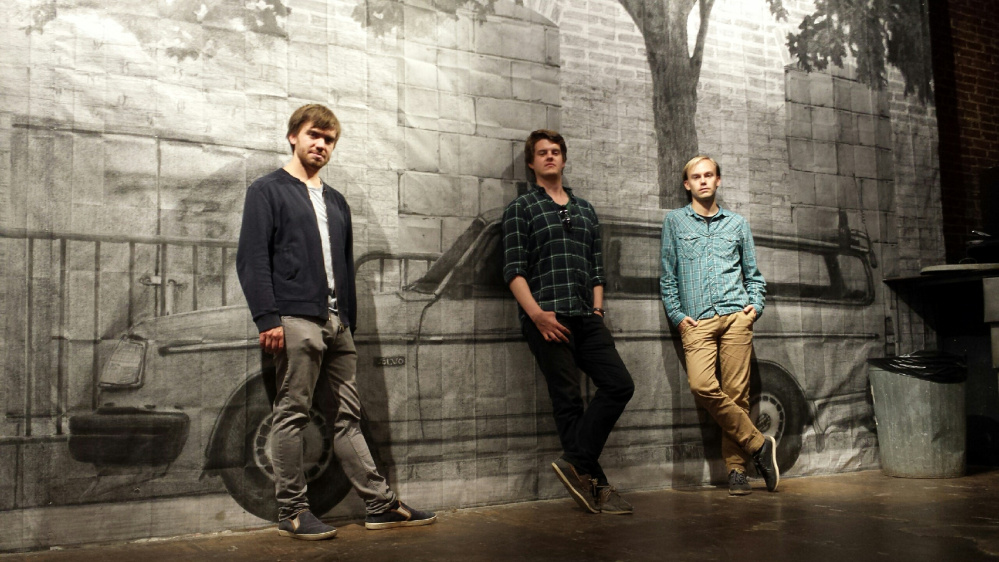The Portland Chamber Music Festival presents most of its concerts in the summer, but since 2012 it has also offered occasional programs of contemporary works at SPACE Gallery. Its presentation on Tuesday evening, “Sounds Unseen,” had an experimental underpinning that made it hard to resist. The Olsen Trio, a young ensemble formed in Oslo in 2010, played works by Peteris Vasks, Alfred Schnittke and Arvo Pärt, as well as Bach Sonata in G major (BWV 1019) for a wrenching touch of perspective, entirely in the dark. The idea, the ensemble said, was that the vast majority of our perception is visual, but when we cannot see, we are forced to focus more fully on our other senses. Free from the distractions of program books, a concert space’s architecture or decoration, the odd outfits people across the aisle are wearing, and furtive glances at their watches, the theory goes, audiences will really listen.
With the exception of a red exit sign that did not throw much light, all lighting in the gallery was extinguished, and to further the sense of listening purity, the ensemble asked that programs not be distributed in advance. If you happened to get one, and memorized it before the concert, your effort was to no avail: They played the works in a different order. They also left no pauses between works; the sold-out audience held its applause until the end of the intermissionless 75-minute program.
A dark hall, of course, is a sword that cuts two ways. Besides removing distractions for the audience, it also removes the possibility of visual communication that chamber ensembles generally rely on. In a piano trio, that often takes the form of the pianist and violinist intently watching the cellist for the downbeat. A nod may signal a change of tempo, or a leap into a suddenly robust passage. The Olsens get around this by memorizing their scores – and some of them were tough, modernist works with flexible tempos – and rehearsing intently.
They had another method of avoiding potential train wrecks as well. Two of the five works were solo pieces. Steven Walter, the group’s cellist, gave a suitably eerie performance of Vasks’ “Pianissimo,” and its pianist, Mathias Susaas Halvorsen, gave a meditative, shapely account of Pärt’s gentle “Für Alina.” Magnus Boye Hansen, the trio’s violinist, was more of a daredevil: With six unaccompanied violin works by Bach to choose from, he played one of the accompanied sonatas with Halvorsen. Hansen and Halvorsen also played Schnittke’s spiky, explosive Sonata No. 2. Only a piano trio by Vasks, “episodi e canto perpetuo,” required the full ensemble.
For the record, the Olsens’ concerts-in-the-dark are not unprecedented. The German composer Georg Friedrich Haas intended his String Quartet No. 3 (2001) to be performed in the dark. I heard the JACK Quartet give a 70-minute performance of the Haas in New York. The two experiences were similarly bracing and clarifying. You do focus more closely on what you’re hearing when you have nothing to look at, and you quickly realize that you have no sense of how much time has elapsed.
You may, for example, have been more critical (and then, perhaps, more forgiving) of Hansen’s and Halvorsen’s tentativeness at the start of the Bach, and more relieved as the performance quickly gelled. And you would have been astonished at the taut performance of Schnittke’s difficult score, with its sudden bursts of sound amid irregular silences, and its constant shifting of tension levels, to say nothing of the demands its range of colors and effects make on each player’s technique. But you also would have noticed that more often than not, Schnittke has either the piano or the violin begin a passage, with the other joining later.
In a way, the temptation to work out how the musicians were doing it, rather than just taking in the performance, became a distraction of its own. So did trying to figure out what caused the light whirring in the gallery, audible during quiet passages, or, for that matter, reacting to the humidity in the tightly packed space. Some listeners may have found the experience unnerving; at any rate, several left before the end, using their phones to light the way out.
Concerts being, to some extent, communal events (if not necessarily social ones, at least during the performance) you wouldn’t want this approach to become standard, or even common. There is a lot to be said, too, for being able to watch the interplay between the musicians on stage, or simply the movement of hands across strings and keys. But sensory deprivation makes for a provocative change, now and again, and if nothing else, you left with a sense of the Olsen players’ individual virtuosity.
Allan Kozinn is a former music critic and culture writer for The New York Times who lives in Portland. He can be contacted at:
allankozinn@gmail.com
Twitter: kozinn
Send questions/comments to the editors.


